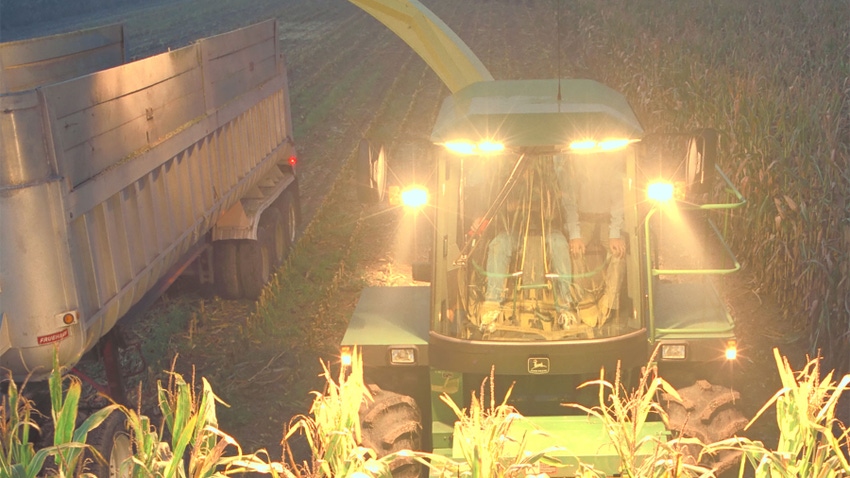August 8, 2023

Determining when the 2023 corn crop will mature will be a challenge in the Northeast.
Most areas received little moisture after planting this spring. Soil variability and lack of rain resulted in extreme variations in germination, and subsequent corn height and growth stage within rows.
When drenching rains returned, the crop responded. and it led to much more prominent variation. This is most evident in the non-uniform tassel emergence that we experienced in early July.
What is physiological maturity?
This is the time when the corn kernel has filled and all flow of nutrients to it have ceased. At physiological maturity, or PM, kernel moisture is about 32%, which is well past silage harvest parameters.
The plant begins to dry down rapidly at maturity. Most of the green tissue turns brown, and the ears dry down rapidly for dry grain harvest or high-moisture corn.
Methods to predict PM
There are two methods to arrive at a physiological maturity timetable.
One is a simple count of calendar days to maturity from tassel emergence. For example, if a field was observed to have tasseled (silked) on July 4, then in 55 to 65 days, most hybrids will be mature (accounting for hybrid and heat accumulation differentials). This year, that would place PM between Aug. 31 and Sept. 12.
Silage harvest is typically 42 to 47 days from tassel (silk). This would be a calendar-day estimate to half milk line, which might be too dry for a bunker and too wet for an oxygen-tight structure. This would place silage harvest from between Aug. 15 and Aug. 20.
The practical implication is that if a field is typically harvested for silage around Labor Day and that rule of thumb is applied this year, the silage might be too dry or wet for its intended storage.
There is no substitute for checking corn ears for relative maturity as it develops.
The second method is using growing degree days. These are calculated daily and represent the average heat units the crop receives from sunlight, and therefore, they offer a more accurate measure of when to harvest.
The calculation involves getting the high temperature and the low temperature for the day to get an average. This is then subtracted from the base temperature of the crop. In the case of corn, the base temperature is 50 degrees.
Here is an example: Take the normal daily high temperature of 80 degrees and low of 60 degrees — 80 plus 60 — and then divide by two. Your average should be 70 degrees.
Then, take the average 70 degrees and subtract the base temperature from it — 50 degrees. The crop would receive 20 growing degrees for that day.
Tools for GDD
The Climate Smart Farming Growing Degree Day Calculator from Cornell University is a handy tool that can calculate growing degree days. Simply put in your address, and the calculator will give you growing degree days accumulated on your farm.
Pioneer provides a growing degree day calculator, as does Green Cast from Syngenta.
You should calculate growing degree days every day until the GDD for silage or physiological maturity is reached. Note that this will vary by hybrid and growing season, which explains why there could be two-week differences in calculated and realized maturities that we see from year to year.
Predicting silage harvest
Most hybrids planted in southeast Pennsylvania will require about 2,000 growing degree days from planting to reach half milk line, which roughly corresponds to 65% whole-plant moisture.
The most accurate way to predict corn silage harvest timing is by tracking growing degree days and using historical data to guide your forecasted growing degree day date. Then, chip and dry down your whole plant to calculate the exact moisture content.
Predicting GDD accumulation should give you a good time frame to decide when to start randomly sampling stalks from your field, and then chipping them — use your chopper or a lawn chipper — to dry down the plant to calculate moisture levels.
A general rule of thumb is that most silages will accumulate about 0.5% dry matter — or lose 0.5% of moisture — each day it matures. However, in extreme weather conditions, hybrids can lose anywhere from 0.0% to 1.0% moisture each day.
When in doubt, chip samples and dry them to verify. You should also consider emergence date as GDD accumulation does not start until the seed has adequate moisture for germination. This could push back your “planting date” by as much as one to two weeks.
Optimal silage quality is closely tied to whole-plant moisture. Generally, we target 65% moisture to provide the best compromise of dry matter yield per acre, fiber digestibility and starch digestibility. Your target moisture level will vary depending on the type of storage used on your farm.

Recent research and observations from Bill Cox, emeritus professor of crop and soil sciences at Cornell University, shows that most hybrids under 100 RM require about 750 GDDs from silking to silage harvest, and most hybrids from 101-115 RM require about 800 GDDs from silking to silage harvest.
We can look to technology to better time harvests. Computer and phone applications such as Bushel Farm, Climate Fieldview and many others allow growers to map a field or fields, and then check daily for comparisons of this year's GDDs compared to either 10- or 15-year averages, and better adjust estimated harvest timing.
With cloudy overcast days and the smoke from the Canadian wildfires, it is highly recommended to keep scouting fields until ideal timing is noted by field observation.
Source: Penn State Cooperative Extension
Read more about:
WeatherYou May Also Like




